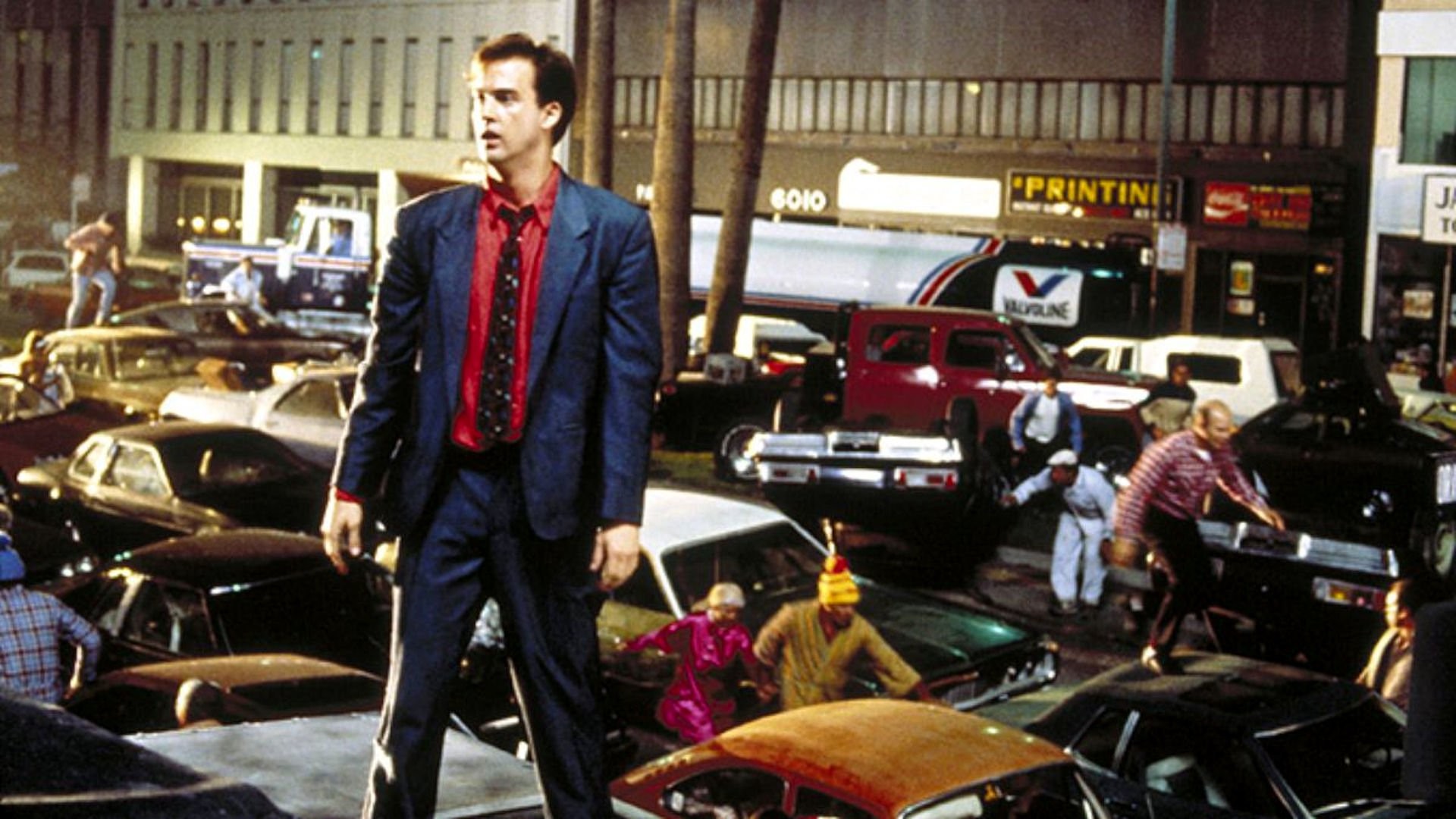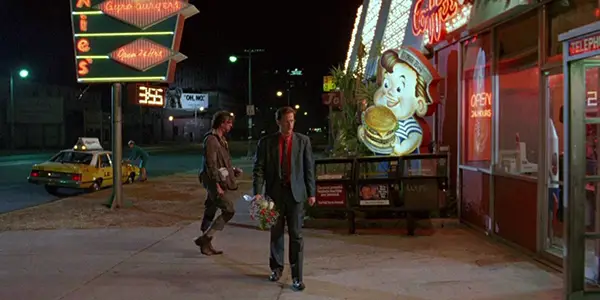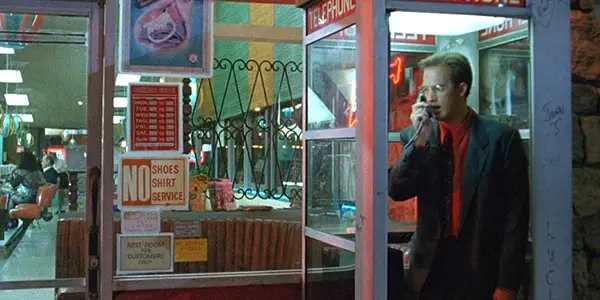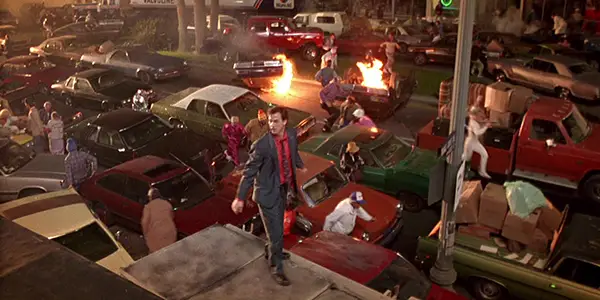“Fifty Minutes And Counting”: Time & MIRACLE MILE

Brian Brems is an Associate Professor of English and Film…
The symbolic end of the Cold War came in November of 1989 with the fall of the Berlin Wall. That crumbling stone that had divided East and West Germany since the end of the Nazis’ Third Reich seemed to take with it the old dichotomy between the United States and the Soviets, the capitalists and the communists. Most of all, the threat of total nuclear annihilation, visited upon the earth by the itchy trigger finger of one or both of the world’s only two superpowers, was about to be, for all intents and purposes, a thing of the past.
The nuclear threat would not subside completely, but the new paradigm’s fears placed less emphasis on the delivery of such a blow by a tyrannical nation-state, and more so on the rogue actor, terrorist cell, or theocratic regime – nuclear materials ‘falling into the wrong hands,’ in other words. This particular scenario has been the catalyst for numerous action and suspense films since the Wall fell, up to and including summer 2018’s Mission: Impossible – Fallout. Prior to Ethan Hunt’s latest global misadventure, terrorists stole a Navy ship to sell its nuclear warheads to the highest bidder in Under Siege (1992), planned to nuke Miami in James Cameron’s True Lies (1994), and succeeded in nuking Baltimore in 2002’s The Sum of All Fears. NASA even hired oil drillers to nuke an incoming asteroid in 1998’s Armageddon.
But before these terrorist cells and roughnecks attempts’ to use nukes for ill and good, there were the Soviets, and the Cold War nuclear nightmare, which fueled the immediacy of the impending apocalypse, seemingly always a hair’s breadth from happening. On film, there were the twin nuclear accident movies of the early 1960s, Stanley Kubrick’s Dr. Strangelove (1963), the absurdist comedy, and Sidney Lumet’s Fail-Safe (1964), the intense drama. The 1970s brought the renegade home, as a disgraced general occupies a nuclear missile silo by force in Twilight’s Last Gleaming (1977).
In 1983, the TV movie The Day After terrified millions, while War Games did the same on the big screen. Each presumed the inevitability of man’s self-destruction, that something, even the smallest thing, could and would go wrong. Sometimes we would stop it, and sometimes we would not, but in all of these films, the certainty of uncertainty dominates. The disconnect between what man had created and what could destroy man had never been more closely aligned.
Steve De Jarnatt’s Miracle Mile, released in 1988, got in just under the wire. Just a few years later, in a post-fall-of-the-Berlin-Wall world, the film would be a dusty artifact of a bygone age. In it, lonely trombonist Harry (Anthony Edwards) finds romance with waitress Julie (Mare Winningham), only to have it interrupted by a late-night pay telephone call from a silo worker who warns of impending nuclear war. Harry takes the call by accident, and becomes an unlikely doomsayer, telling the patrons of a diner that the missiles will hit Los Angeles in about an hour. Harry must collect Julie from her apartment and make it to a helicopter to escape before time is up and the end comes for everyone.
Harry plays the trombone for a big-band era revival group – their gig’s attendees are few in number and getting on in years. He makes a living propping up a dying genre of music, its brassy swing contrasted with Tangerine Dream’s pulsing electronic score, one of the band’s final major contributions to film composition. Above all, Miracle Mile is a film about time running out. Harry and Julie have just begun their courtship, but are in danger of losing it all. The city itself begins to decline, as word of the attack spreads and societal structures collapse. And above all, in the background, the Cold War itself is about to end. De Jarnatt’s film brings the era to a close in a glorious supernova of neon fury, a last gasp of total apocalyptic disintegration of the moral and social order.
Extinction Event
One of Miracle Mile’s first images is of ‘The Big Bang.’ It’s not the bomb, but the one that created the universe. From the opening moments, De Jarnatt draws attention to the bookends of existence, demonstrating the film’s preoccupation with beginnings and endings. Miracle Mile’s opening credits sequence takes place in a museum, where Harry first meets Julie. In voice-over narration, Harry tells us that he’s searched for thirty years for the perfect woman, and he’s finally found her. He steps out of frame, and behind him, a wall of fossils, preserved for display in a glass case, trivialize his existence.
Right away, the narrative indicates the importance of pegging life experience to the ticking clock. Despite his relative youth, Harry sees Julie as his last chance in the way that desperate romantics often do, even with strangers glimpsed across a crowded public space. This fateful meeting occurs amidst a collection of extinction exhibits, as animals of long-gone epochs stare at fixed points with dead eyes, their snarling faces baring sharp teeth glinting in the fluorescent glow of the museum.

De Jarnatt’s camera floats through the museum space, tracking left-to-right to follow Julie or Harry as they intersect with each other through the exhibit; the credits’ text floats across the screen from right-to-left, heightening the contradiction between the birth of a romance and the death of previous biological generations. Here, the ironic clash between life and death is bereft of hope. Harry and Julie are not falling in love in the tragic, star-crossed lovers mold of Jack and Rose, whose love sank beneath the waves in an accident of history. Their love is powerless to stop what’s coming, an indifferent universe occupied by the whims of unseen men who are about to blow them up. There’s nothing they can do – they fall in love, maybe, but what’s the point?
Late in Miracle Mile, after they are reunited, Harry and Julie take shelter inside a department store. A stolen police car crashes through the front window, and the couple hides from the SWAT team gathered outside near a commercial display in the back of the store. They’re surrounded by clocks, their faces bearing down on the increasingly desperate would-be lovers. De Jarnatt shoots Harry and Julie each from below, giving the clocks more weight. Each human subject is centrally framed, with shelf after shelf of clocks hemming them into the middle of the image. From a thematic sense, the visuals reinforce the panic. Faced with hundreds of individual reminders of time slipping away, all seems nearly lost.
Keep On Rolling
One of the techniques De Jarnatt uses throughout Miracle Mile is the long take. Though none of the extended camera shots bear the acrobatic distance or creativity of Brian De Palma’s best offerings, nor do they run for more than several minutes, De Jarnatt withholds cuts throughout the film, often letting the camera linger on a specific pair of characters. The result is an arrhythmic editing style that is difficult to track, but when the cuts come, they are abrupt and decisive.
As Julie waits on the street for Harry to meet her for their date, De Jarnatt creates a montage pinned to the spinning digital clock affixed to the diner’s neon sign. The clock swirls, its face changing from 12:16 to 12:42 to 1:05 to 1:15 with each revolution, an hour’s time gone in seconds, intercut with Julie’s disappointed slump as she realizes she’s been stood up. The montage is built on the idea that time can slip away in an instant, a curiously counterintuitive move at this moment, which depicts Julie’s hour-long sidewalk vigil.
Another choice, like crossfading between Julie and the clock, might enhance the feeling of duration, if not extending the film’s running time itself by more than a negligible amount. Dissolves slow moments down, and cuts speed them up. An hour is gone in the blink of an eye, foreshadowing Miracle Mile’s main narrative, which has yet to begin. When the stakes are relatively low, time vanishes quickly, taken for granted.

When the stakes are high, as they will be when Harry receives the fateful pay phone call, time stretches out. Every moment seems precious and valuable. When Harry steps into the phone booth to answer it, presuming it might be Julie returning his call, De Jarnatt’s camera settles in to a lengthy shot that slowly pushes in on Harry as he hears the news from the panicked silo worker on the other end.
The experience of the call is frighteningly real, something the unbroken take emphasizes. It begins as a medium shot, as a confused Harry listens to the raving maniac on the other end of the phone, screaming in panic that “this is it!” and “we shoot our wad in fifty minutes!” The camera doesn’t push in until Harry finally responds, interrupting the raving voice on the other end of the phone. By the time the shot ends, and the voice is snuffed out by the clatter of machine guns, Harry is locked in compressed close-up, smashed into the frame by the dawning realization that this really might be it.
One of De Jarnatt’s crucial narrative decisions is to delay confirmation of the impending nuclear attack until the last possible moment, leaving the film perilously ambiguous. As the denizens of the all-night diner snap into action, making a break for a nearby airport, and Harry splits from them to get Julie, whether the missiles are actually in flight is never confirmed. Harry believes they might be, but he isn’t quite sure. As Miracle Mile escalates, and Harry carjacks a stereo thief named Wilson (Mykelti Williamson), then evades police capture in an incident that leaves two officers dead in an accidental explosion, the narrative itself builds towards apocalypse.
The terror of Miracle Mile, though, is not in the nuclear annihilation, but in the way it portrays man’s self-destruction. The bombs may or may not be in flight, but De Jarnatt is more interested in how societal structures begin to collapse with the slightest pressure. Harry’s warning spreads slowly throughout the city, but by dawn, everybody seems to know. A chaotic scene at Miracle Mile’s climax depicts total breakdown. The street is lined with cars, jammed together in a crush of metal, honking horns echoing off the buildings. People are looting supplies, while others jump on top of cars to avoid the throng. Some have been trampled and lie in the gutter. Everyone is armed and dangerous.
In this moment, whether the apocalypse is on its way is immaterial. The bombs may fall, but the end of the world is already here. De Jarnatt’s coup de grace is a crane shot that begins as Harry leaps on top of a car to get away from a bloodthirsty mob. He turns around to face the street, and stares in horror at what he hath wrought. The camera cranes up and back. What he sees before him may be the culmination of the long threatened nuclear standoff, a cold war finally gone hot. Or, it may be his fault, an overreaction to a stupid crank call. Either way, it’s too late. It doesn’t matter anymore.
Mutually Assured Destruction
Miracle Mile is the last one through the gate before the geopolitical order was completely upended by what scholars and pundits at the time, perhaps too hastily, dubbed “the end of history.” Its characters and the production itself stand at the precipice of total annihilation, and the moment of its release lends Miracle Mile a confrontational gaze. It looks into the heart of darkness as the citizens of Los Angeles reckon with their own destruction, but also catalogs its own obsolescence. In this way, it parallels the conversation between Harry and Julie as the helicopter, their once-imagined means of escape, sinks beneath the blackness of the La Brea Tar Pits with them trapped inside.
Julie, knowing their time is up, tries to hold on to hope: “People are gonna help each other, aren’t they? Rebuilding things?” Harry is much more fatalistic: “I think it’s the insects’ turn.” Julie is slow to face what Harry already knows; they are about to be just as extinct as the fossils around them. This is the way their world ends, with a bang, and then a whimper.

As many Cold War era films demonstrate, the madness of M.A.D. was the ultimate horror, precisely because it felt so possible. All it would take is one computer glitch, one hot-tempered demagogue, one strategic assault, and the entire fabric of everything humankind had built over centuries would be reduced to ash and rubble. And though the immediacy of the Cold War fades in the aftermath of Miracle Mile, the fear of nuclear destruction did not entirely subside with it.
Instead, it became much more diffuse, finding harbor in the action film, where rogue groups of non-state actors try frantically to get their hands on dirty bombs to achieve maximum terror. After 9/11, the images of ruined, smoking craters where American landmarks used to be dominated (and continue in perpetuity) the superhero film genre, each of which conclude with rescuers flying in to save the city from total obliteration at the last possible moment. In this way, Miracle Mile marks the end of an era of cinema that presented an apocalypse whose authors were certain. In its aftermath, many more potential villains stepped forward, each willing to bring life on this planet to an end.
Miracle Mile suggests it wouldn’t take much more than a simple nudge to push humanity over the brink. Its characters are far removed from the geopolitics of the Cold War, and have no ability to stop what’s coming. Their goal is to survive, somehow, some way. They don’t. The Cold War thriller, as it lived during its historical moment, would not either.
How did the Cold War nuclear thriller change after the end of the Cold War?
Does content like this matter to you?
Become a Member and support film journalism. Unlock access to all of Film Inquiry`s great articles. Join a community of like-minded readers who are passionate about cinema - get access to our private members Network, give back to independent filmmakers, and more.
Brian Brems is an Associate Professor of English and Film at the College of DuPage, a large two-year institution located in the western Chicago suburbs. He has a Master's Degree from Northern Illinois University in English with a Film & Literature concentration. He has a wife, Genna, and two dogs, Bowie and Iggy.













